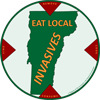Encouraging people to eat invasive species is controversial even though many individuals, organizations and governmental programs have begun to promote this strategy. Scientists have voiced a significant concern about this tactic: if we reframe invasive plants and animals as “good food,” we may create market demand that results in their propagation, instead of their reduction or elimination. A second concern is that the plants can be spread unintentionally when people are unfamiliar with specific harvesting practices. The SRNE acknowledges and shares these concerns but still endorses the consumption of local invasives as more beneficial than harmful in cumulative impact. In most cases communities won’t be able to eliminate these tough, pervasive plants by eating them. However, this program has additional benefits. It has the power to raise awareness about the problem of invasive species. As a result, it can motivate a larger number of people to help remove the plants whenever and wherever they find them. Removing the plants by hand is far better than using herbicides and chemical poisons, which cause many other environmental problems. Finally, while some people may be motivated to gather plants for the environmental benefits, others will be more responsive when they realize that local invasives have culinary benefits. WARNING! Foraging and eating wild plants is a potentially dangerous activity. The SRNE & BD Collier have provided good-faith information on how to get started, but we take no responsibility for personal harm caused by careless or irresponsible collection, preparation and consumption of any wild plants. The deadly poisonous Water Hemlock and Poison Hemlock may be mistaked for Wild Parsnip and Wild Carrot. |
